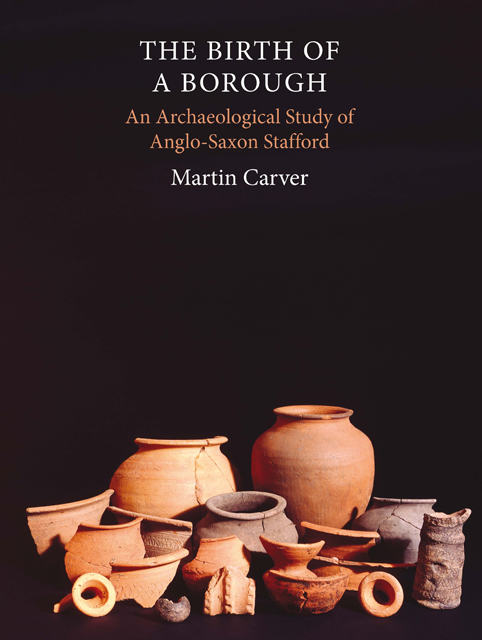Book contents
- Frontmatter
- Contents
- List of Illustrations
- Preface
- Acknowledgements
- Abbreviations
- 1 Questions
- 2 Digging up Stafford: Evaluation and Design
- 3 Seven Windows on Early Stafford: The Principal Investigations
- 4 Æthelflæd’s Town
- 5 Aftermath: Norman and Medieval Stafford
- 6 Anglo-Saxon Stafford in Context
- Digest A1 Archaeological Interventions at Stafford to 1988
- Digest A2 Dendrochronological and Radiocarbon Dates
- Digest A3 Pottery Seriation
- Digest A4 Key to Pottery Illustrations
- Digest A5 Excavated Structures
- Digest A6 Contents of the Stafford Online Archive: http://ads.ahds.ac.uk/catalogue/archive/stafford_eh_2009
- Bibliography
- Index
6 - Anglo-Saxon Stafford in Context
Published online by Cambridge University Press: 17 February 2023
- Frontmatter
- Contents
- List of Illustrations
- Preface
- Acknowledgements
- Abbreviations
- 1 Questions
- 2 Digging up Stafford: Evaluation and Design
- 3 Seven Windows on Early Stafford: The Principal Investigations
- 4 Æthelflæd’s Town
- 5 Aftermath: Norman and Medieval Stafford
- 6 Anglo-Saxon Stafford in Context
- Digest A1 Archaeological Interventions at Stafford to 1988
- Digest A2 Dendrochronological and Radiocarbon Dates
- Digest A3 Pottery Seriation
- Digest A4 Key to Pottery Illustrations
- Digest A5 Excavated Structures
- Digest A6 Contents of the Stafford Online Archive: http://ads.ahds.ac.uk/catalogue/archive/stafford_eh_2009
- Bibliography
- Index
Summary
Introduction: The origin of the burh idea
The archaeological campaign examined the sequences at each of our chosen ‘windows’, following the story in each case from its beginning, in Iron Age or Roman times, to its end, usually in the sixteenth century (Chapter 3). From this inquiry emerged the information that the Late Saxon period at Stafford was a prominent one – as indeed had been predicted by the evaluation and targeted by the research design. Summarising the contacts we made with Æthelflæd's burh (Chapter 4) and its spasmodic aftermath (Chapter 5) has only taken us so far in understanding why it was as we believed it to be. Explanation of the model and endorsement or critique of its interpretation must now be sought from its contemporary context. What was the likely genesis of the burh, the rationale for the selection of its site, the inspiration for its design, the purpose of its industries? Does it belong to a series of initiatives special to Mercia, or can we see it as a standard instrument of the Wessex mission? Do its idiosyncrasies betray the solution to a local problem or an underlying trait of early English urbanism more generally? In this chapter I will attempt to start addressing this daunting agenda.
As summarised in Chapter 1, the Anglo-Saxon Chronicle and the Mercian Register offer a broad historical context to the early events and activities that have been elucidated by archaeological research at Stafford. In his wars with the Danes of the later ninth century, Alfred of Wessex introduced a defensive system based on a network of forts, or burhs, with dedicated garrisons designed to confront raiders and protect local people. The strategy was successful, and in the early years of the tenth century the war was carried into midland and northern England under the direction of Alfred's son Edward the Elder, his daughter Æthelflæd and her husband Ethelred, who between them built twenty-eight or more burhs. Stafford was one of these.
Historians have raised expectations that the choice and development of a burh site should depend on what was there before and we shall examine two of the most prominent theories: that the burh was an adaptation of a pre-existing tribute centre – which I call the royal hypothesis– or that it was a development of an ecclesiastical centre – the minster hypothesis.
- Type
- Chapter
- Information
- The Birth of a BoroughAn Archaeological Study of Anglo-Saxon Stafford, pp. 127 - 146Publisher: Boydell & BrewerPrint publication year: 2010



